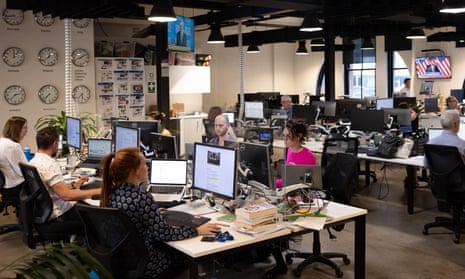I don’t need the archives to remember how it felt in May 2013 as we prepared to launch Guardian Australia; the excitement and exhaustion, and also the underlying fluttering of fear.
Our hope and determination was tinged with anxiety because we were embarking on an experiment most experts thought impossible; building a new and consequential news provider in Australia. We were backed by the global heft of the Guardian’s news platforms and cushioned by a generous five-year loan from the philanthropist Graeme Wood, but we were launching into a market that had long centred on just two commercial news brands, Fairfax Media and News Corp. And we were starting small.
Looking back through the archives I found the interview given by our first editor Katharine Viner (now the Guardian’s global editor-in-chief) to Radio National breakfast on launch day, 27 May 2013. You can hear the slight tone of uncertainty in Fran Kelly’s voice as she asks: “So why does Australia need Guardian Australia?”
Viner replied that we brought true independence, guaranteed to be free of commercial or shareholder influence by virtue of our ownership structure; that we were built for the new era of digital news; and that we were truly international. All good reasons. But we also had an editorial staff of fewer than 20.
A few weeks earlier Kelly had interviewed the then chief executive of Fairfax, Greg Hywood, who had dismissed the Guardian as “a good brand in a few suburbs in London” but added: “The fact is both us and News Ltd provide hundreds of journalists and a depth of journalism every day through our publications, and to set up a website with a handful of people and bought-in content is not a real player in this game.”
Ten years later we have proved him wrong. We’re not yet as big as Nine Entertainment or News Corp but we definitely are a “player”, an influential force in Australian news. But at the time we knew there was a chance he might be right. We hoped Australia’s concentrated media landscape was not the way things would always be, and we trusted there would be a readership for something different – but we couldn’t be certain.
The readers came at once. The Guardian had about 1 million unique Australian readers each month before we launched, people who liked our international coverage. That jumped quickly to 2 million a month. It’s now well over 7 million.
When we set up we thought a global news organisation could survive on ad revenue alone but, three years later, about the time I took over Guardian Australia’s editorship, the advertising market felt the full force of Google and Facebook’s domination. Again we turned to our readers, trusting that they would pay for news they valued if they were able to, to help it remain available to those who could not. Now reader revenue accounts for more than half our income.
Our existence has even been used as a justification to allow our competitors to get bigger still. When the merger of Nine Entertainment and Fairfax was approved in 2018, the Australian Competition and Consumer Commission acknowledged that the deal reduced competition in the market for Australian news and information but said it did not reduce competition sufficiently to be in breach of the law because “other players, albeit smaller, now provide some degree of competitive constraint”. The first listed “other player” was us, Guardian Australia.
After 10 years we have paid back Wood’s loan and expanded to a staff of 167. And we have made a difference. We have set our own tone; unashamedly progressive but never partisan. We seek to report for the powerless and the people subjected to the exercise of power, not in the interests of those who wield it. We try to listen and understand the experience of our readers and help them make sense of the world as it is. And we strive to find ideas about how we can act to create a better one.
We have always sought to follow facts wherever they lead and we’ve never seen “balance” as reporting both well-informed views and misinformation. If someone is demonstrably spreading untruths, then that is what we say.
We have expanded how we tell stories, reaching new audiences through podcasting and video and social media. We started with an emphasis on politics, the environment, Indigenous affairs and asylum policy, as well as general news. Over the years we have expanded where we operate to include state news and reporting on rural and regional Australia and also on the Pacific and New Zealand, and we have broadened our coverage of culture, lifestyle and sport.
The most common thing we hear from you, our readers, is that you can’t imagine Australian news without us. It’s been an exciting decade and we know we wouldn’t be where we are without you. We want to spend the next 10 years getting bigger, having an even greater impact and serving you better.
To celebrate our birthday, we are holding a special evening for supporters with Guardian editors and journalists. You can buy tickets here

